Octagonal Quasicrystal Defect Mode Laser-Based PVK: Ir(ppy)3 Polymer Driven by Optical Pumping
Abstract
:1. Introduction
2. Photoluminescence Spectra of PVK: Ir(ppy)3
3. Resonator
4. Experiment Results and Discussion
5. Conclusions
Author Contributions
Funding
Institutional Review Board Statement
Informed Consent Statement
Data Availability Statement
Conflicts of Interest
References
- Shirakawa, H.; Louis, E.J.; MacDiarmid, A.G.; Chiang, C.K.; Heeger, A.J. Synthesis of electrically conducting organic polymers: Halogen derivatives of polyacetylene, (CH) X. J. Chem. Soc. Chem. Commun. 1977, 16, 578. [Google Scholar] [CrossRef]
- Samuel, I.D.W.; Turnbull, G.A. Organic semiconductor lasers. Chem. Rev. 2007, 107, 1272–1295. [Google Scholar] [CrossRef] [PubMed]
- Moses, D. High quantum efficiency luminescence from a conducting polymer in solution: A polymer laser dye. Appl. Phys. Lett. 1992, 60, 3215–3216. [Google Scholar] [CrossRef]
- Tessler, N.; Denton, G.J.; Friend, R.H. Lasing from conjugated-polymer microcavities. Nature 1996, 382, 695. [Google Scholar] [CrossRef]
- Hide, F.; DiazGarcia, M.A.; Schwartz, B.J.; Andersson, M.R.; Pei, Q.B.; Heeger, A.J. Semiconducting Polymers: A New Class of Solid-state Laser Materials. Science 1996, 273, 1833. [Google Scholar] [CrossRef]
- Holzer, W.; Penzkofer, A.; Gong, S.H.; Bleyer, A.; Bradley, D.D.C. Laser action in poly (m-phenylenevinylene-co-2,5-dioctoxy-p-phenylenevinylene). Adv. Mater. 1996, 8, 974. [Google Scholar] [CrossRef]
- Kuehne, A.J.; Gather, M.C. Organic Lasers: Recent developments on materials, device geometries, and fabrication techniques. Chem. Rev. 2016, 116, 12823–12864. [Google Scholar] [CrossRef] [PubMed] [Green Version]
- Lehnhardt, M.; Riedl, T.; Weimann, T.; Kowalsky, W. Impact of triplet absorption and triplet-singlet annihilation on the dynamics of optically pumping organic solid-state lasers. Phys. Rev. B 2010, 81, 165206. [Google Scholar] [CrossRef]
- Gartner, C.; Karnutsch, C.; Lemmer, U.; Pflumm, C. The influence of annihilation processes on the threshold current density of organic laser diodes. J. Appl. Phys. 2007, 101, 023107. [Google Scholar] [CrossRef]
- Kozlov, V.G.; Bulovic, V.; Burrows, P.E.; Baldo, M.; Khalfin, V.B.; Parthasarathy, G.; Forrest, S.R.; You, Y.; Thompson, M.E. Study of lasing action based on Förster energy transfer in optically pumped organic semiconductor thin films. J. Appl. Phys. 1998, 84, 4096–4108. [Google Scholar] [CrossRef]
- Minev, Z.K.; Pop, I.M.; Devoret, M.H. Planar superconducting whispering gallery mode resonators. Appl. Phys. Lett. 2013, 103, 142604. [Google Scholar] [CrossRef] [Green Version]
- Pourdavoud, N.; Mayer, A.; Buchmüller, M.; Brinkmann, K.; Haeger, T.; Hu, T.; Heiderhoff, R.; Shutsko, I.; Görrn, P.; Chen, Y.; et al. Distributed Feedback Lasers Based on MAPbBr3. Adv. Mater. Technol. 2018, 3, 1700253. [Google Scholar] [CrossRef]
- Tanabe, T.; Notomi, M.; Kuramochi, E.; Shinya, A.; Taniyama, H. Trapping and delaying photons for one nanosecond in an ultrasmall high-Q photonic crystal nanocavity. Nat. Photon. 2007, 1, 49–52. [Google Scholar] [CrossRef]
- Painter, O.; Lee, R.K.; Scherer, A.; Yariv, A.; O’brien, J.D.; Dapkus, P.D.; Kim, I. Two-dimensional photonic band-gap defect mode laser. Science 1999, 284, 1819–1821. [Google Scholar] [CrossRef] [PubMed] [Green Version]
- Romero-Vivas, J.; Chigrin, D.N.; Lavrinenko, A.V.; Torres, C.S. Resonant add-drop filter based on a photonic quasicrystal. Opt. Express 2005, 13, 826. [Google Scholar] [CrossRef] [PubMed]
- Wang, X.M.; Wang, X.; Wen, Y.P. Study of Photoconductive Effect of PVK. J. Harbin Univ. Sci. Technol. 2007, 12, 50–54. [Google Scholar]
- Gourdon, F.; Chakaroun, M.; Fabre, N.; Solard, J.; Cambril, E.; Yacomotti, A.M.; Bouchoule, S.; Fischer, A.; Boudrioua, A. Optically pumped lasing from organic two-dimensional planar photonic crystal microcavity. Appl. Phys. Lett. 2012, 100, 213304. [Google Scholar] [CrossRef]
- Takeuchi, H.; Natsume, K.; Suzuki, S.; Sakata, H. Microcavity distributed-feedback laser using dye-doped polymeric thin films. Electron. Lett. 2007, 43, 30–31. [Google Scholar] [CrossRef]
- Wan, W.; Huang, W.; Pu, D.; Qiao, W.; Ye, Y.; Wei, G.; Fang, Z.; Zhou, X.; Chen, L. High performance organic distributed Bragg reflector lasers fabricated by dot matrix holography. Opt. Express 2015, 23, 31926–31935. [Google Scholar] [CrossRef]
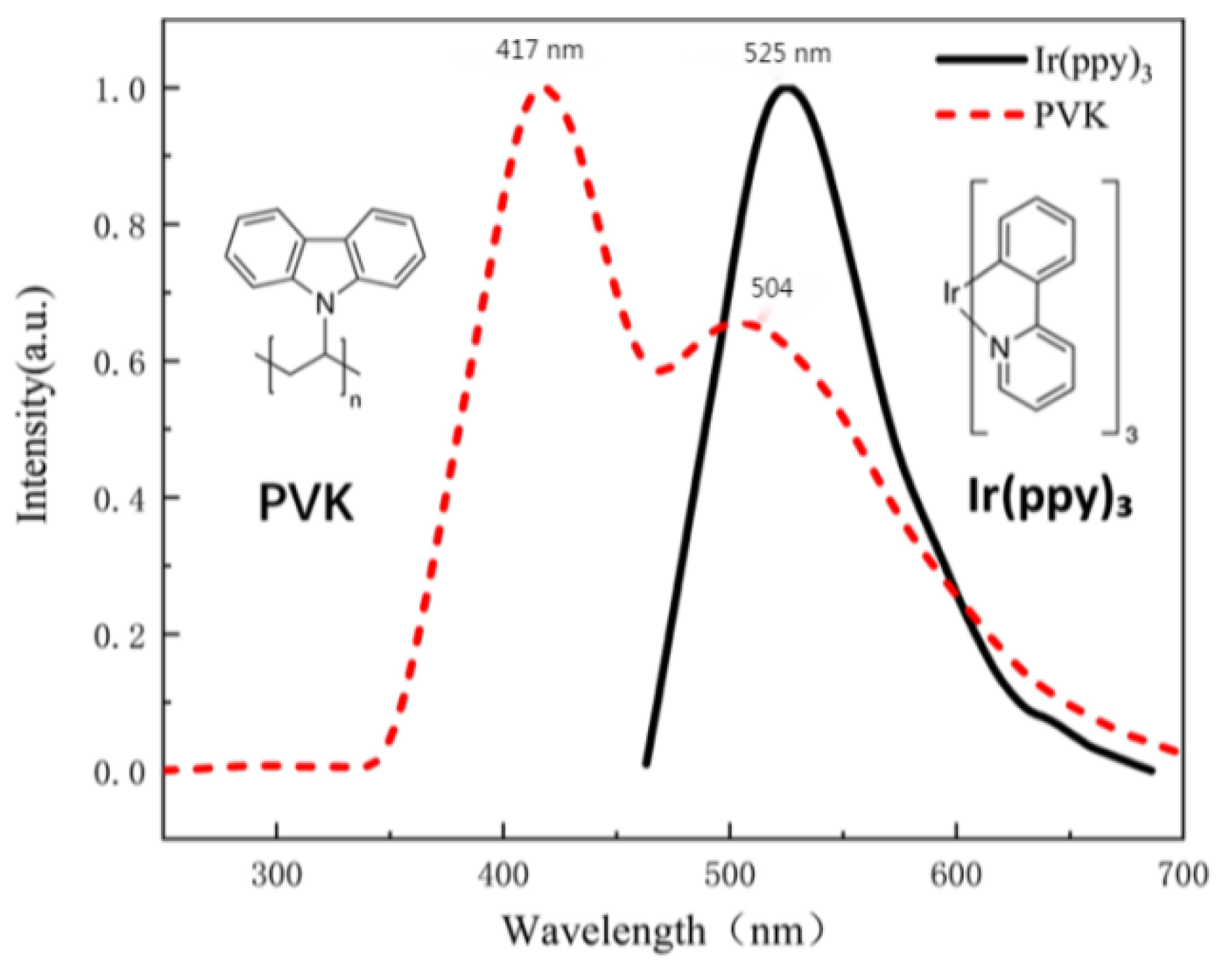
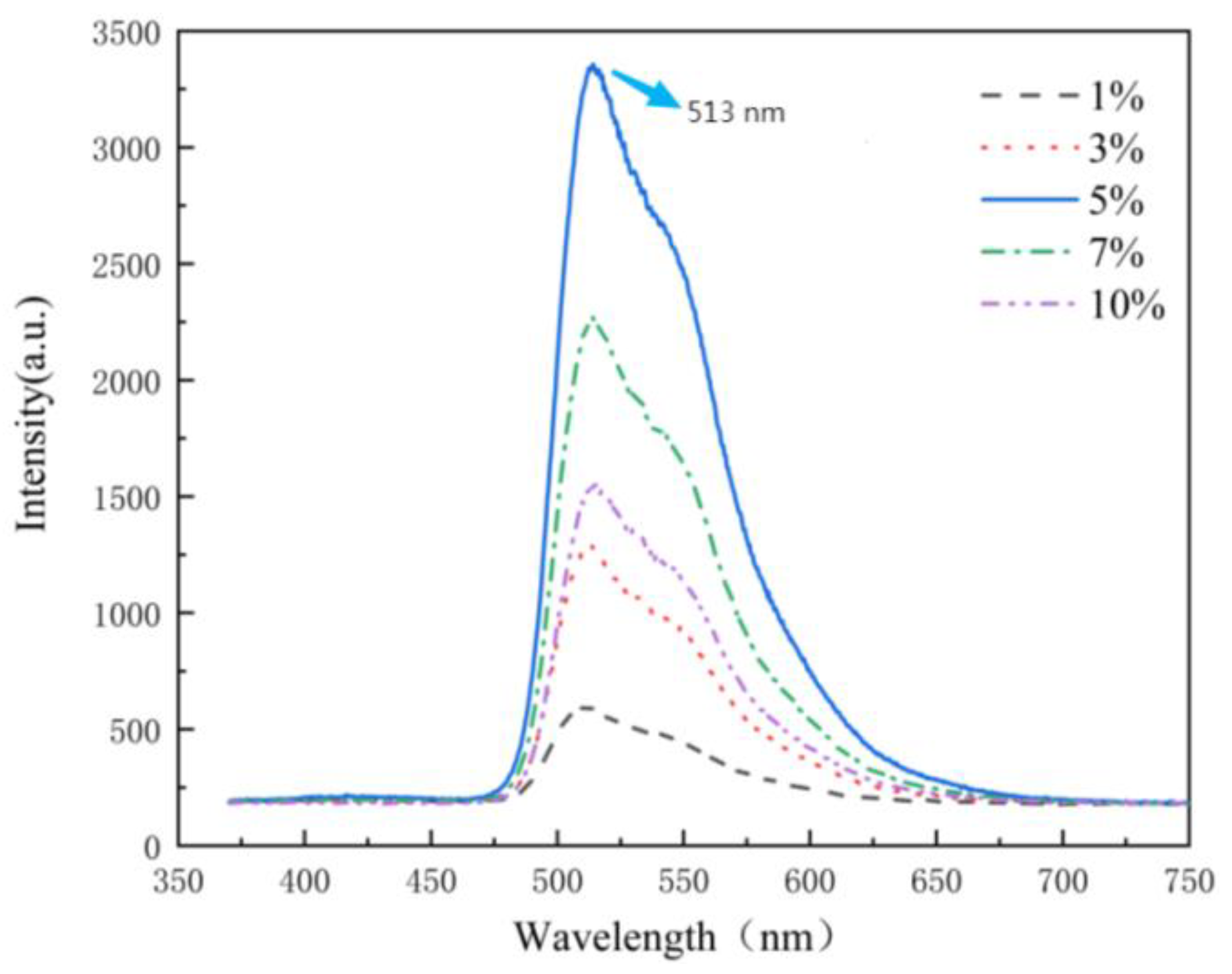
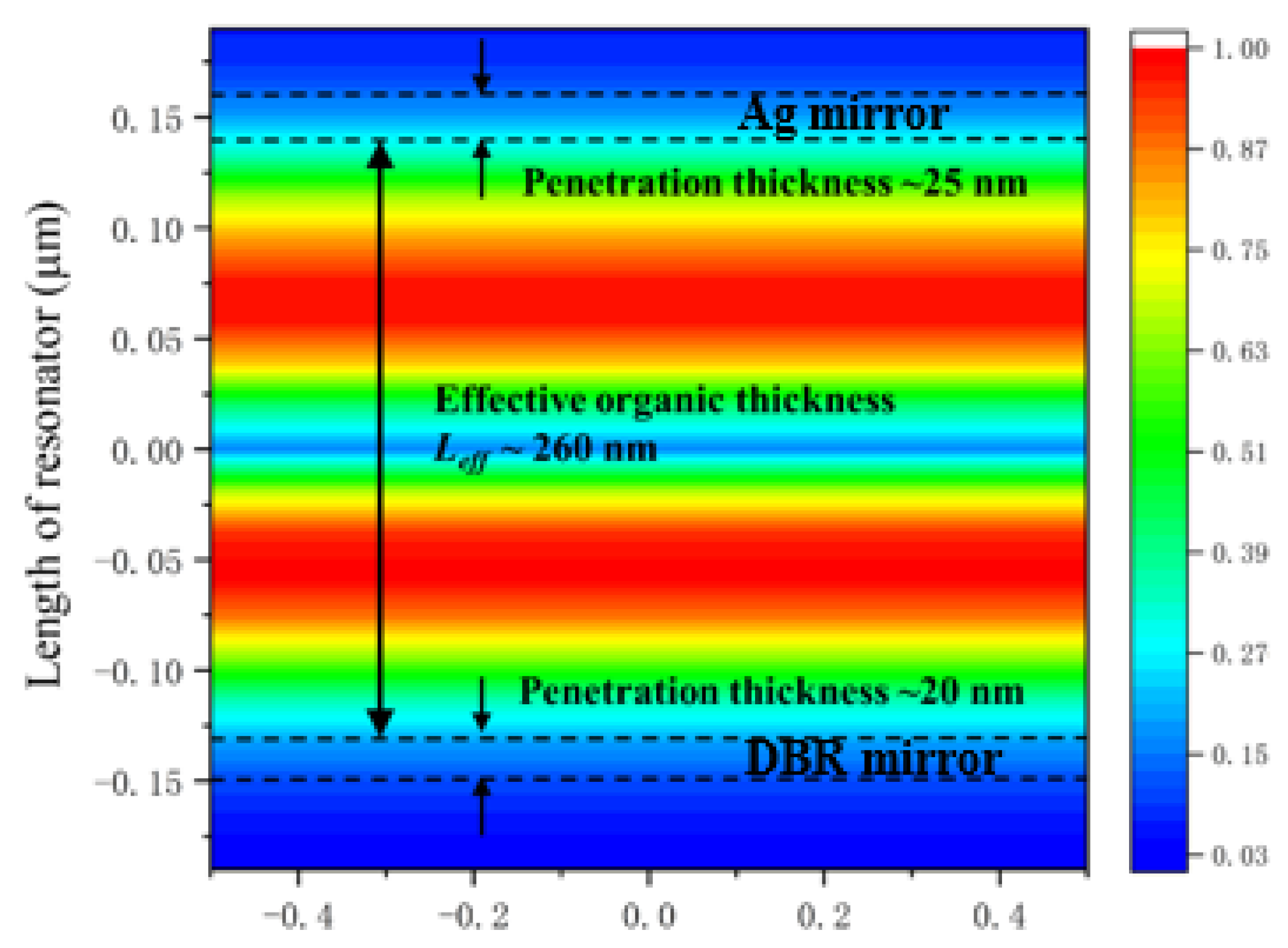
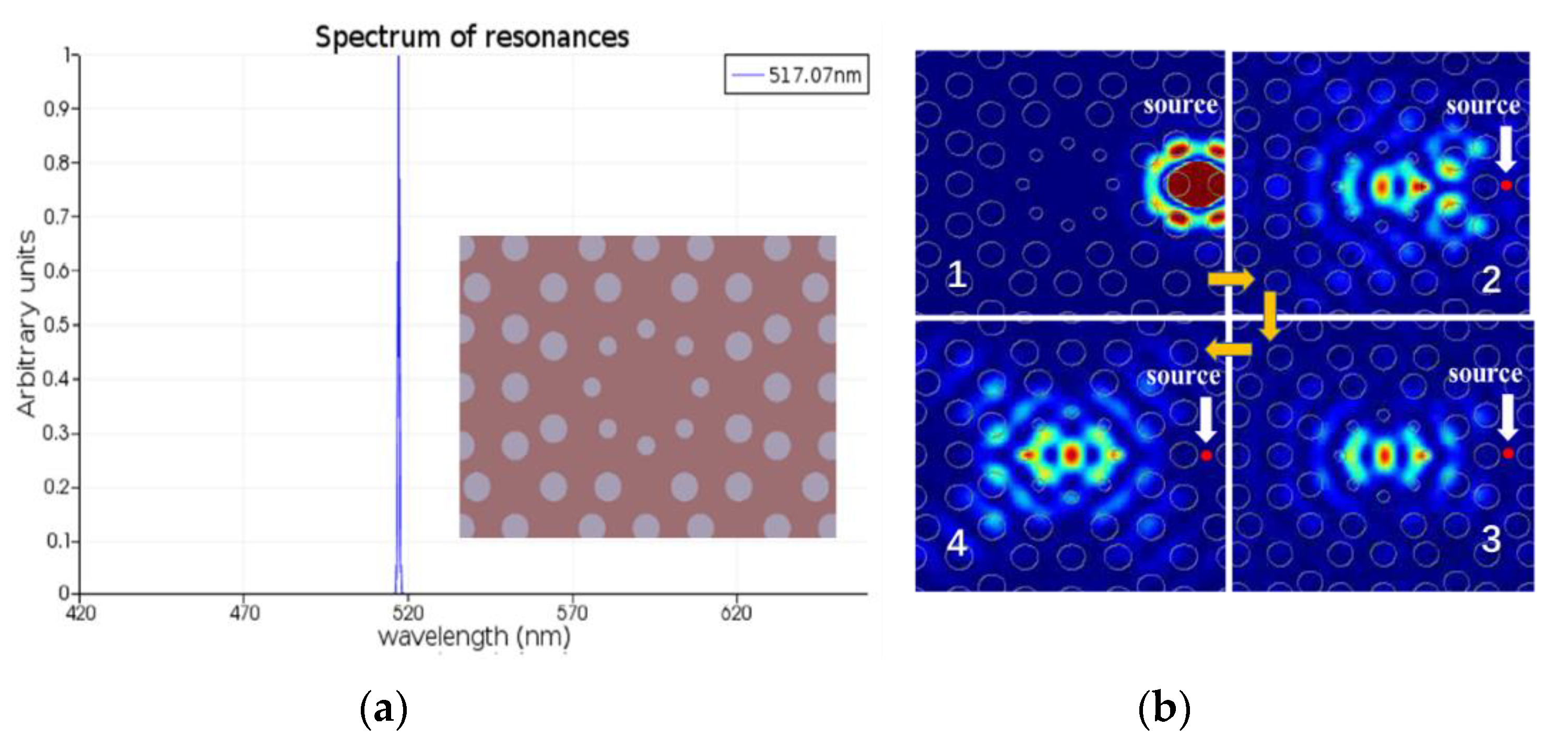


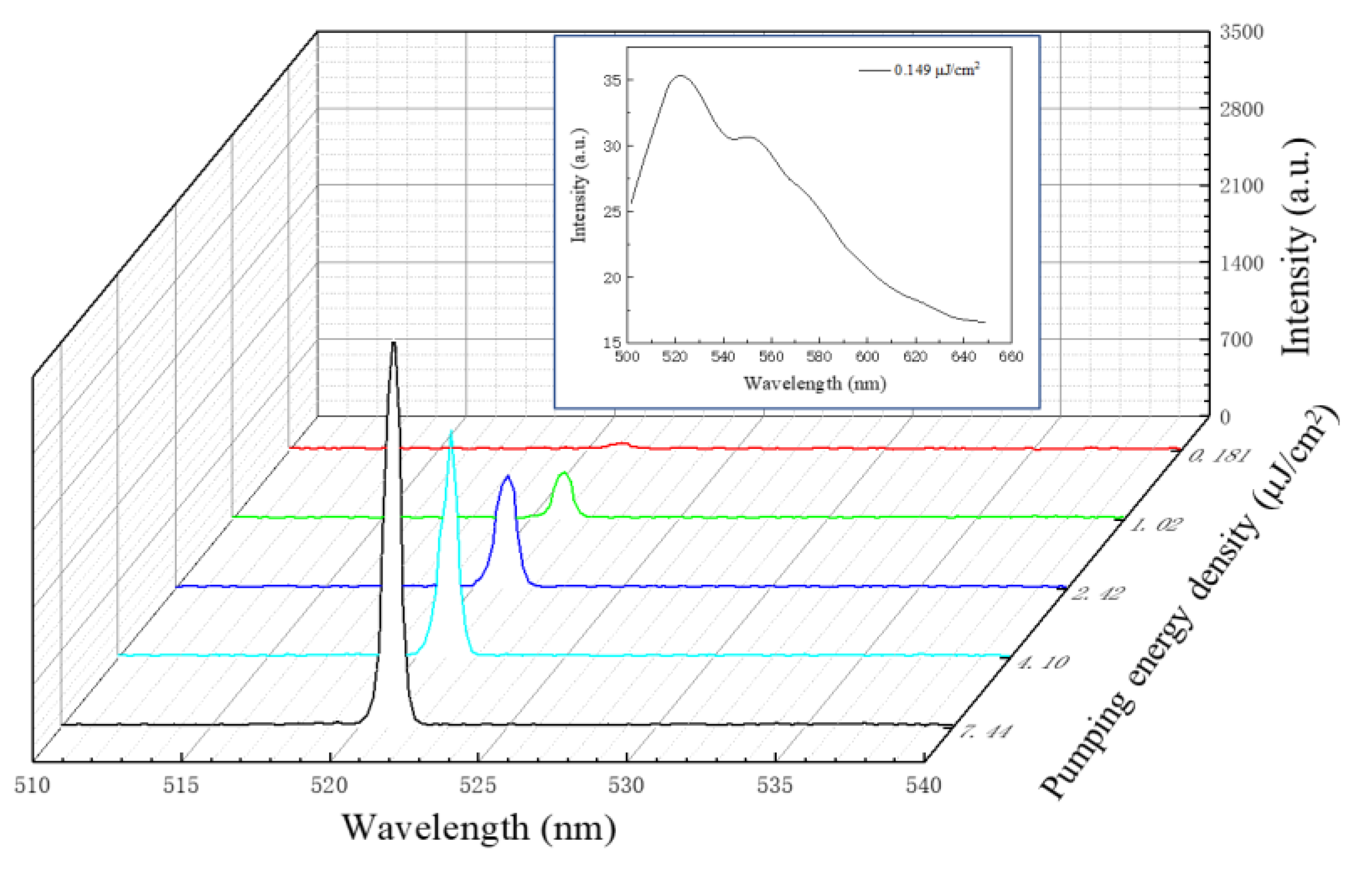
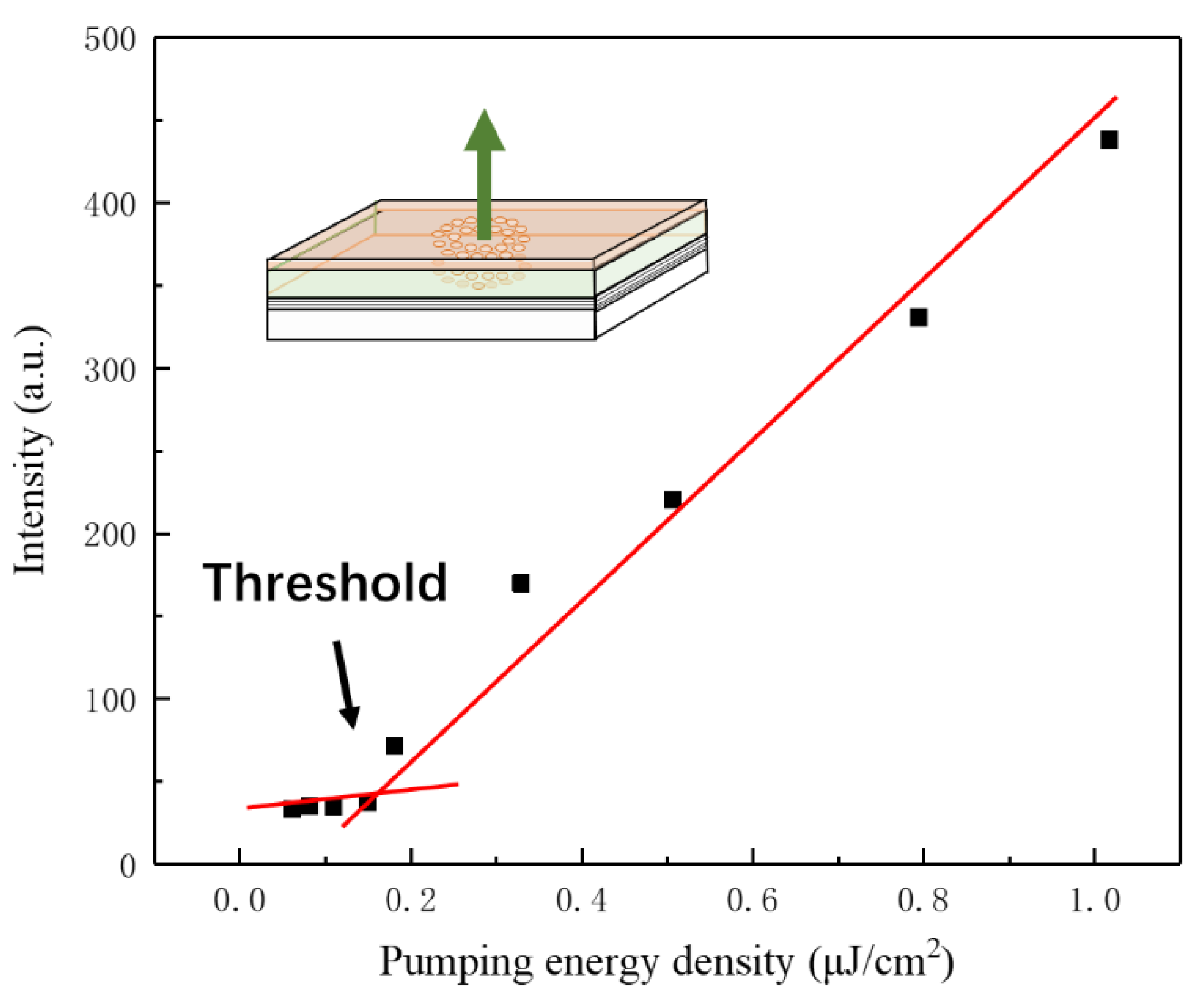
Publisher’s Note: MDPI stays neutral with regard to jurisdictional claims in published maps and institutional affiliations. |
© 2022 by the authors. Licensee MDPI, Basel, Switzerland. This article is an open access article distributed under the terms and conditions of the Creative Commons Attribution (CC BY) license (https://creativecommons.org/licenses/by/4.0/).
Share and Cite
Cai, Y.; Zhang, S.; Wu, C.; Wang, Z.; Xu, W.; Chen, X.; Wang, Y. Octagonal Quasicrystal Defect Mode Laser-Based PVK: Ir(ppy)3 Polymer Driven by Optical Pumping. Nanomaterials 2022, 12, 1386. https://doi.org/10.3390/nano12091386
Cai Y, Zhang S, Wu C, Wang Z, Xu W, Chen X, Wang Y. Octagonal Quasicrystal Defect Mode Laser-Based PVK: Ir(ppy)3 Polymer Driven by Optical Pumping. Nanomaterials. 2022; 12(9):1386. https://doi.org/10.3390/nano12091386
Chicago/Turabian StyleCai, Yuanyuan, Shuai Zhang, Chenyu Wu, Zhiwei Wang, Weiran Xu, Xiao Chen, and Yiquan Wang. 2022. "Octagonal Quasicrystal Defect Mode Laser-Based PVK: Ir(ppy)3 Polymer Driven by Optical Pumping" Nanomaterials 12, no. 9: 1386. https://doi.org/10.3390/nano12091386




